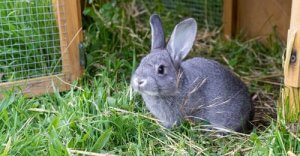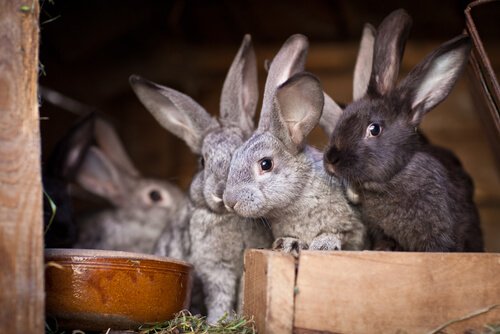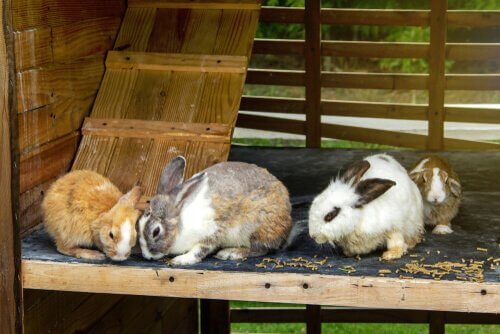A Rabbit Hutch, the Ideal Home for Your Rabbit

A rabbit hutch is the place where your rabbit will spend most of the day. All rabbits need a home and a place that’s made just for them. However, creating the perfect place for your rabbit may require a lot of ingenuity.
Before you start, you may have a few questions. How big should the rabbit hutch be? What materials should I use to build the best home for my rabbit? Should the rabbit hutch be inside or outside?
There are so many different options when it comes to building a home for your rabbit. As the owner, it’s your responsibility to make sure your rabbit has enough space to exercise, be amused, and rest.
One of the most important characteristics that this type of enclosure must have is enough space for your rabbit to move around. As you know, rabbits’ bodies are designed to spend the day jumping and running through fields.
When a rabbit doesn’t have enough space to move and jump, his health will be severely affected. Among the consequences of lack of movement are osteoporosis, obesity and muscle deterioration.
An ideal rabbit hutch
The most popular enclosure among rabbit owners is a hutch. You have to be careful when choosing a rabbit hutch, since a lot of the cheaper ones don’t meet the necessary requirements. Whether for lack of space or because of cheap materials, low-quality rabbit hutches will always be more expensive in the long term.

A good rabbit hutch will give your rabbit enough space to move freely throughout the day, and he’ll be able to comfortably sleep at night. Additionally, a rabbit hutch should keep him safe from predators, as well as inclement weather.
A good rabbit hutch will have several different levels, an will be very large. Ideally, you should buy a custom-made rabbit hutch, or you can even build your own. If you decide to build your own, you should keep the following things in mind.
1. Size
When it comes to rabbits and their hutches, bigger is always better. The minimum measurements for a burrow are precisely that—minimum. In the UK, for example, the minimum size of a hutch is 71x24x24 inches.
If you want your rabbit to live happily and comfortably, we recommend giving him a hutch that’s much larger than that. Remember, a rabbit needs a lot of space to jump and run.
2. The safety of the rabbit hutch
When building a home for your rabbit, you should make sure that it’s a completely safe environment. From the door to the corners, a hutch must be built with the safety of the inhabitants in mind.
The door should be secured with more than just a wooden latch. There are many medium-sized predators that know how to open these kinds of doors. Additionally, if you have small children at home, you don’t want them to accidentally leave the hutch door open.
If you’re planning on using mesh, you should use mesh with a vertical/horizontal pattern. We don’t recommend chicken wire, since it’s easy for the rabbits’ legs to get caught in it.

When choosing which type of mesh to use, make sure each hole is smaller than 3/4 inch. If they’re any wider than this, cats or other predators can fit their legs through them, and may torment your rabbits.
3. Distance from the ground and soil quality
The hutches should always be off the ground, because they can easily be affected by humidity. If you decide to buy a legless rabbit hutch, you can always build your own legs.
Remember, the hutch’s floor should be firm and flat. You should never use mesh on the hutch floor, because your rabbits won’t be able to jump and run as easily.
To protect the soil from organic waste, we recommend installing vinyl. Vinyl is an excellent option for your hutch because it’s very easy to clean and maintain.
Conclusion
As you can see, choosing the right home for your rabbit requires a lot of care and attention. Building your own rabbit hutch may take more time, but you’ll also get better results. You have to keep in mind that your rabbits need space to live a full life.
A rabbit who doesn’t have enough space may develop poor habits. Among these habits are repetitive or destructive behavior of their environment, as well as apathy. All these behaviors indicate a lack of mental stimulation.
A rabbit can only act like a rabbit if he has enough space to do so. If it’s impossible to give your rabbit that much space, you may want to consider giving him up for adoption. It’s important to remember that a rabbit will only be happy if he can move about freely.
A rabbit hutch is the place where your rabbit will spend most of the day. All rabbits need a home and a place that’s made just for them. However, creating the perfect place for your rabbit may require a lot of ingenuity.
Before you start, you may have a few questions. How big should the rabbit hutch be? What materials should I use to build the best home for my rabbit? Should the rabbit hutch be inside or outside?
There are so many different options when it comes to building a home for your rabbit. As the owner, it’s your responsibility to make sure your rabbit has enough space to exercise, be amused, and rest.
One of the most important characteristics that this type of enclosure must have is enough space for your rabbit to move around. As you know, rabbits’ bodies are designed to spend the day jumping and running through fields.
When a rabbit doesn’t have enough space to move and jump, his health will be severely affected. Among the consequences of lack of movement are osteoporosis, obesity and muscle deterioration.
An ideal rabbit hutch
The most popular enclosure among rabbit owners is a hutch. You have to be careful when choosing a rabbit hutch, since a lot of the cheaper ones don’t meet the necessary requirements. Whether for lack of space or because of cheap materials, low-quality rabbit hutches will always be more expensive in the long term.

A good rabbit hutch will give your rabbit enough space to move freely throughout the day, and he’ll be able to comfortably sleep at night. Additionally, a rabbit hutch should keep him safe from predators, as well as inclement weather.
A good rabbit hutch will have several different levels, an will be very large. Ideally, you should buy a custom-made rabbit hutch, or you can even build your own. If you decide to build your own, you should keep the following things in mind.
1. Size
When it comes to rabbits and their hutches, bigger is always better. The minimum measurements for a burrow are precisely that—minimum. In the UK, for example, the minimum size of a hutch is 71x24x24 inches.
If you want your rabbit to live happily and comfortably, we recommend giving him a hutch that’s much larger than that. Remember, a rabbit needs a lot of space to jump and run.
2. The safety of the rabbit hutch
When building a home for your rabbit, you should make sure that it’s a completely safe environment. From the door to the corners, a hutch must be built with the safety of the inhabitants in mind.
The door should be secured with more than just a wooden latch. There are many medium-sized predators that know how to open these kinds of doors. Additionally, if you have small children at home, you don’t want them to accidentally leave the hutch door open.
If you’re planning on using mesh, you should use mesh with a vertical/horizontal pattern. We don’t recommend chicken wire, since it’s easy for the rabbits’ legs to get caught in it.

When choosing which type of mesh to use, make sure each hole is smaller than 3/4 inch. If they’re any wider than this, cats or other predators can fit their legs through them, and may torment your rabbits.
3. Distance from the ground and soil quality
The hutches should always be off the ground, because they can easily be affected by humidity. If you decide to buy a legless rabbit hutch, you can always build your own legs.
Remember, the hutch’s floor should be firm and flat. You should never use mesh on the hutch floor, because your rabbits won’t be able to jump and run as easily.
To protect the soil from organic waste, we recommend installing vinyl. Vinyl is an excellent option for your hutch because it’s very easy to clean and maintain.
Conclusion
As you can see, choosing the right home for your rabbit requires a lot of care and attention. Building your own rabbit hutch may take more time, but you’ll also get better results. You have to keep in mind that your rabbits need space to live a full life.
A rabbit who doesn’t have enough space may develop poor habits. Among these habits are repetitive or destructive behavior of their environment, as well as apathy. All these behaviors indicate a lack of mental stimulation.
A rabbit can only act like a rabbit if he has enough space to do so. If it’s impossible to give your rabbit that much space, you may want to consider giving him up for adoption. It’s important to remember that a rabbit will only be happy if he can move about freely.
All cited sources were thoroughly reviewed by our team to ensure their quality, reliability, currency, and validity. The bibliography of this article was considered reliable and of academic or scientific accuracy.
- Crespo, R. (1925) Conejos y conejeras. taller Calpe, Madrid.
- Zotyen Quan, C. (2002) La cunicultura: crianza de conejos.
- V.A.A. (1996) El conejo: cría y patología. Organización de las Naciones Unidas para la Agricultura y la Alimentación. Roma.
This text is provided for informational purposes only and does not replace consultation with a professional. If in doubt, consult your specialist.








